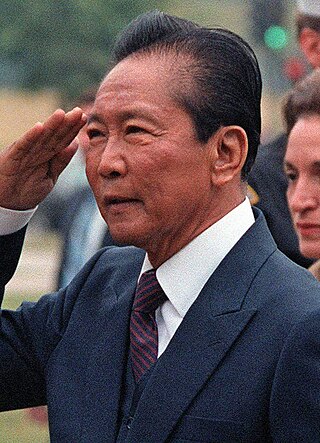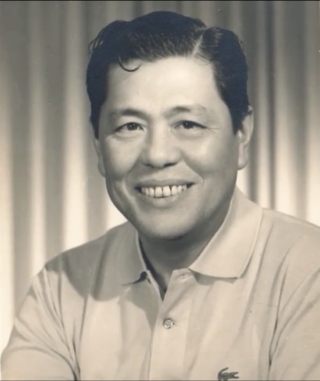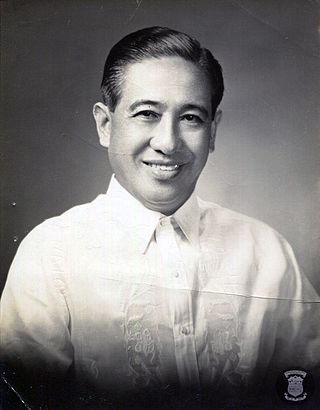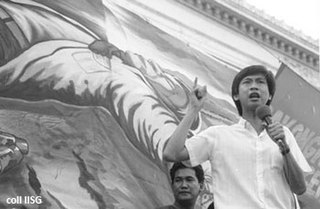
Maria Corazon "Cory" Sumulong Cojuangco-Aquino was a Filipino politician who served as the eleventh president of the Philippines from 1986 to 1992. She was the most prominent figure of the 1986 People Power Revolution, which ended the two-decade rule of President Ferdinand Marcos and led to the establishment of the current democratic Fifth Philippine Republic.

Benigno "Ninoy" SimeonAquino Jr., was a Filipino politician who served as a senator of the Philippines (1967–1972) and governor of the province of Tarlac. Aquino was the husband of Corazon Aquino, who became the 11th president of the Philippines after his assassination, and father of Benigno Aquino III, who became the 15th president of the Philippines. Aquino, together with Gerardo Roxas and Jovito Salonga, helped form the leadership of the opposition towards then President Ferdinand Marcos. He was the significant leader who together with the intellectual leader Sen. Jose W. Diokno led the overall opposition.

The Bagong Alyansang Makabayan or Bayan is an alliance of left-wing Philippine organizations. It was founded on International Workers' Day, May 1, 1985 as part of the opposition during the Marcos dictatorship.

The People Power Revolution, also known as the EDSA Revolution or the February Revolution, was a series of popular demonstrations in the Philippines, mostly in Metro Manila, from February 22 to 25, 1986. There was a sustained campaign of civil resistance against regime violence and electoral fraud. The nonviolent revolution led to the departure of Ferdinand Marcos, the end of his 20-year dictatorship and the restoration of democracy in the Philippines.
The Coalition Against the Marcos Dictatorship was a North America-based antiimperialist organization that was at the center of the international movement opposing the dictatorship of Philippine President Ferdinand Marcos from the 1970s.

A parliamentary election was held in the Philippines on April 7, 1978, for the election of the 165 regional representatives to the Interim Batasang Pambansa. The elections were participated in by the leading opposition party, the Lakas ng Bayan (LABAN), which had twenty-one candidates for the Metro Manila area while the leading candidate was the jailed opposition leader Ninoy Aquino, and the Marcos regime's party known as the Kilusang Bagong Lipunan (KBL), which was led by the then-First Lady Imelda Marcos. Ninoy was allowed to run by his fellow partymates under the Liberal Party, who boycotted the election and was not allowed to campaign, and so his family campaigned for him. The night before the election on April 6, 1978, a noise barrage was organized by the supporters of (LABAN) which occurred up to dawn.

Jose Wright Diokno, also known as "Ka Pepe", was a Filipino nationalist, lawyer, and statesman. Regarded as the "Father of Human Rights," he served as Senator of the Philippines, Secretary of Justice, founding chair of the Commission on Human Rights, and founder of the Free Legal Assistance Group (FLAG), the premier group of Filipino human rights lawyers. Diokno is the only person to top both the Philippine Bar Examination and the board exam for Certified Public Accountants (CPA). His career was dedicated to the promotion of human rights, the defense of Philippine sovereignty, and the enactment of pro-Filipino economic legislation.

The United Nationalist Democratic Organization (UNIDO) was the main political multi-party electoral alliance of the traditional political opposition during the turbulent last years of Philippine President Ferdinand Marcos in the mid-1980s. It was formed in January 1980, and was originally known as the United Democratic Opposition from 1980 to 1982. It was initially a union of eight major and minor political parties and organizations with the main aim to oust President Marcos through a legal political process. In April 1982, the coalition received its present name, and increased its members to twelve parties. Shortly after the assassination of popular opposition senator Benigno Aquino Jr., the party was led by Senator Salvador Laurel of Batangas.

A parliamentary election was held on May 14, 1984, in the Philippines. Like past elections, charges of bribery, protests and complaints on irregularities marred the elections. Former Manila Times publisher Chino Roces and former senator and opposition leader Jose W. Diokno supported the campaign boycotting the election. The National Movement for Free Elections (NAMFREL) helped mitigate electoral fraud during the election.

The history of the Philippines, from 1965 to 1986, covers the presidency of Ferdinand Marcos. The Marcos era includes the final years of the Third Republic (1965–1972), the Philippines under martial law (1972–1981), and the majority of the Fourth Republic (1981–1986). By the end of the Marcos dictatorial era, the country was experiencing a debt crisis, extreme poverty, and severe underemployment.

The Fourth Philippine Republic, also known as the FourthRepublic of the Philippines was established after Ferdinand Marcos Sr won the June 16, 1981, Philippine Presidential Election. Marcos announced the beginning of the Fourth Republic on June 30, during his inauguration speech. On February 25, 1986, due to the 1986 EDSA Revolution, Marcos ended into exile in Hawaii and Corazon Aquino became the 11th president of the Philippines. The Fourth Republic would come to an end under Aquino's leadership, and the Fifth Republic would commence with the adoption of a new constitution.

Lorenzo Martinez "Ka Tanny" Tañada Sr. was a Filipino statesman, lawyer, human and civil rights defender, and national athlete. He is often referred to as the "Grand Old Man of Philippine Politics."
Lakas ng Bayan, abbreviated as Laban, was a political party in the Philippines formed by Senator Benigno "Ninoy" Aquino Jr. for the 1978 Interim Batasang Pambansa regional elections. The party had 21 candidates for the Metro Manila area, all of whom lost, including Ninoy. The party's acronym (LABAN) is a Filipino word meaning "fight".

Leandro "Lean" Legara Alejandro was a student leader and left-wing nationalist political activist in the Philippines.

Benigno "Ninoy" Aquino Jr., a former Philippine senator, was assassinated on Sunday, August 21, 1983, on the tarmac of Manila International Airport. A longtime political opponent of President Ferdinand Marcos, Aquino had just landed in his home country after three years of self-imposed exile in the United States when he was shot in the head while being escorted from an aircraft to a vehicle that was waiting to transport him to prison. Also killed was Rolando Galman who was accused of murdering Aquino.
The People Power Revolution was a series of popular demonstrations in the Philippines that began in 1983 and culminated in 1986. The methods used amounted to a sustained campaign of civil resistance against regime violence and electoral fraud. This case of nonviolent revolution led to the toppling of dictator Ferdinand Marcos and the restoration of the country's democracy.
The Aquino family of Tarlac is one of the most prominent families in the Philippines because of their involvement in politics. Some family members are also involved in other fields such as business and entertainment.

At 7:15 p.m. on September 23, 1972, President Ferdinand Marcos announced on television that he had placed the Philippines under martial law, stating he had done so in response to the "communist threat" posed by the newly founded Communist Party of the Philippines (CPP), and the sectarian "rebellion" of the Muslim Independence Movement (MIM). Opposition figures of the time accused Marcos of exaggerating these threats and using them as an excuse to consolidate power and extend his tenure beyond the two presidential terms allowed by the 1935 constitution. Marcos' signed Proclamation No. 1081 on September 21, 1972, marking the beginning of a fourteen-year period of one-man rule which effectively lasted until Marcos was exiled from the country on February 25, 1986. Proclamation No. 1081 was formally lifted on January 17, 1981, although Marcos retained essentially all of his powers as dictator until he was ousted in February 1986.

During the presidency of Ferdinand Marcos, Filipino workers in the labor industry experienced the effects of government corruption, crony capitalism, and cheap labor for foreign transnational industries, One of the objectives of Martial Law was to cheapen labor costs, in order to attract transnational corporations to export labor to the Philippines. Marcos signed many presidential decrees beneficial only to his associates, while allowing for the forced relocation of indigenous peoples, decreasing workers' wages, and murders of labor activists. Minimum wage was a fixed PHP8.00 per day. Many workers were unemployed or underemployed. It was also during the Marcos presidency when the practice of contractualization began, enabling managements to avoid giving regular, permanent status to employees after six months of work. Strikes were banned and the government controlled trade unions, leaving workers without effective protection against employers who had unfair labor practices and regulations.

In the Philippines during the dictatorship of Ferdinand Marcos, groups and individuals which opposed the regime without subscribing to leftist ideology were usually labeled with the terms "middle force," "third force," the "mainstream opposition," or more rarely, as the "conservative opposition." Mostly consisting of middle class and upper class groups which had been apolitical when Marcos first declared martial law, the most prominent examples of oppositionists in this category include religious groups, business sector groups, professional groups, social democrats, academics, journalists, and artists. Politicians from the traditional opposition are also sometimes counted in this category, although the terms are traditionally associated with ground level opposition, rather than political opposition per se.















